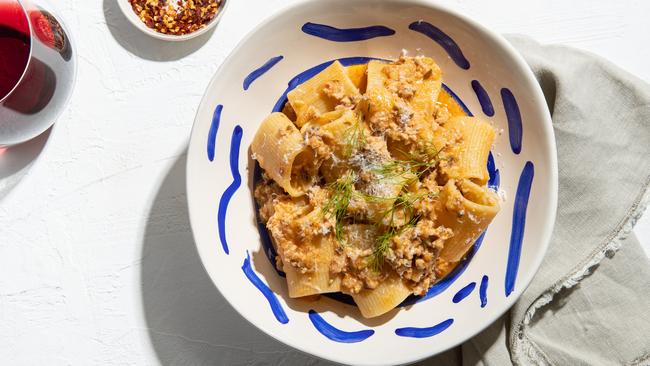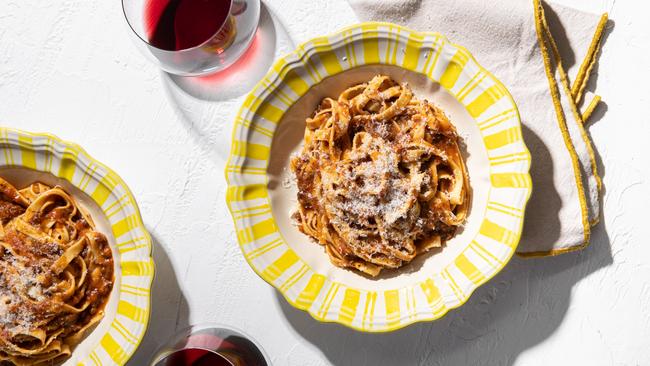With or without meat, Elizabeth Hewson’s ragù recipe will change your life
Few sights lift the spirits like a pot of slowly cooked ragu, especially the way it blips away on the stove, filling the house with an aroma to make your mouth water.

Few sights lift the spirits quite like a big pot of slowly cooked ragu. There’s a lot going for it – the way it blips away on the stove, slowly filling the house with an aroma that makes your mouth water. It makes use of cheaper cuts of meat, transforming them into a dish that somehow feels luxurious, especially when tossed through silky ribbons of pasta. Or the fact that it is universally loved by young and old, far and wide, except for vegetarians (but I’ve got them covered, too).
Some other delicious recipes you may love:
- Pasta perfect for a mid-week meal
- Frutti di mare pasta, your way
- Four pastas that will change your life
The most famous ragù is, of course, Bolognese. While the origins of the dish are not disputed (ragù alla Bolognese originates in Bologna, the capital of Emilia Romagna), it could be argued that it is also one of Australia’s national dishes. Sure, versions found here are worlds apart from what is served in Italy, but there is no denying that we love it. I’d take a good punt that a Bolognese is dished up fortnightly, if not weekly, in Australian households.
Every man and his mum has their own recipe they consider “the best”, a trait I’m sure we picked up from the Italians. I have a family favourite that you can find in my book Saturday Night Pasta, but today I want to share two other “ragu” recipes that hit the spot the same way a Bolognese does. I hope these help shake up your repertoire.
My ragù is inspired by the Italian dish, milk-braised pork. While it’s not the most photogenic dish, it’s one of the tastiest. This white-style ragu is made from white wine and milk, rather than red wine and tomatoes. I do, however, like to add a small squeeze of tomato paste for depth (and colour). The fennel adds a sweetness that brings the ragu together.
While ragù is typically defined as a meat-based sauce, vegetarians should not miss out. I’d challenge the most defiant of meat eaters not to be satisfied with my roast vegetable ragù. It’s full of flavour, full of comfort, and full of heart. Exactly how all ragùs should be.
Now, on to the most contentious issue of them all. Choosing the right pasta shape to match your ragù. As many Italians will tell you, this makes the difference between an ordinary pasta dish and an extraordinary pasta dish. And while I do agree with this, I don’t think it’s as simple as one shape fits one sauce. Throughout Italy, from region to region and town to town, a pasta shape, although maybe with another name, will be paired with a different sauce. You could write a doorstop tome on pasta shapes and sauces – and indeed people have – but here is where I’m going to leave this subject. Similar to wine pairing, there is a point when it comes down to personal preference. This is especially true for spaghetti Bolognese. And while I believe that spaghetti does nothing to enhance the richness and chunkiness of a good bol’, at the end of the day we just really like it.

RECIPE: Roast vegetable ragù
Ingredients
- 1 onion, cut into 6-8 wedges
- 2 medium sticks celery
- 1 whole head of garlic, cut in half
- 2 carrots, cut into 6 sticks
- ½ sweet potato, peeled, cut up in thick slices
- 3 big mushrooms, stalks removed
- 3 tablespoons olive oil
- Salt and pepper
- 1/3 cup brown lentils, rinsed
- 1/3 cup red wine
- 500ml vegetable (or chicken) stock
- 1 x 400ml can whole tomatoes
- 2 tablespoons tomato paste
- 1 bay leaf
- Salt and pepper
- 1 tablespoon butter (optional)
- Handful of Parmigiano Reggiano, plus extra to serve
- Fresh pasta for 6, such as tagliatelle
Method
- Heat oven to 210C (190C fan-forced). Evenly space out your vegetables on a tray (or two). Drizzle over 1 tablespoon of olive oil and give everything a good coat in the oil. Throw into the oven for 30 minutes – you want them to get a bit of colour. Blitz your roasted vegetables in a food processor so they are very finely chopped, almost like a paste. Heat a large deep pan with a lid over medium heat. Add remaining oil and roast veggie puree, and cook for two minutes. Add lentils, stir, and cook for a further 2 minutes.
- Pour in your wine, stock, tomatoes and tomato paste, and give everything a good stir. Add bay leaf, season and bring to the boil. Simmer for a few minutes then reduce heat to low, cover, and cook for at least 2 hours, stirring occasionally. Your ragù should be loose, rich, and full of flavour. Remove from heat and stir in butter.
- Meanwhile, bring a large saucepan of water to a lively boil and season as salty as the sea. Add your pasta and cook until al dente. Scoop out ½ cup of pasta water; drain pasta then toss through ragù with Parmigiano Reggiano and a splash of reserved pasta water. Give everything a good toss around, adding more water if you need; everything should be loose and relaxed. Serve with extra cheese. Serves 6
- Parmigiano Reggiano rinds add an incredible umami hit; I tend to keep a stash of them in the freezer.
RECIPE: Pork and fennel ragu
Ingredients
- ¼ cup olive oil
- 1 small onion, finely chopped
- 1 medium fennel bulb, fronds reserved for serving
- 1 teaspoon fennel seeds
- 2 plump garlic cloves, finely chopped
- 1 teaspoon salt
- 500g free-range pork mince (not too lean)
- 1 birds eye chilli, deseeded and finely chopped
- 1 tablespoon tomato paste
- 125ml dry white wine
- 125ml chicken stock
- 1 bay leaf
- 250ml full-cream milk
- 1 Parmigiano Reggiano rind (optional)
- Zest of 1 lemon
- Handful of Parmigiano Reggiano, plus extra
- Pasta of your liking for 4 (here, I like a short, dried pasta to catch the sauce)
Method
- Add olive oil in a deep-sided pan with a lid over medium to low heat. Throw in onion, fennel, fennel seeds, garlic and salt. Cook, stirring occasionally, for 15 minutes until soft and sweet.
- Add pork, breaking it up with a wooden spoon, and cook for about 5 to 10 minutes until brown. Stir in chilli and tomato paste and cook for a further 2 minutes. Pour in wine, leaving to bubble and boil for a few minutes or until mostly reduced by half. Add stock and bay leaf. Turn heat down to low. Cover and cook for 90 minutes, stirring occasionally.
- Add milk, stir and continue to cook for another hour. If you’re finding your ragù needs more liquid, add a little stock. Turn off heat, and add lemon zest. Check seasoning and adjust if necessary.
- Meanwhile, bring a large saucepan of water to a lively boil and season as salty as the sea. Add your pasta and cook until al dente. Scoop out ½ cup of pasta water; drain pasta then toss in ragù with some Parmigiano Reggiano; add a splash of reserved pasta water to loosen things up. Give everything a good toss around. Serve with extra cheese and fennel fronds. Serves 4


To join the conversation, please log in. Don't have an account? Register
Join the conversation, you are commenting as Logout